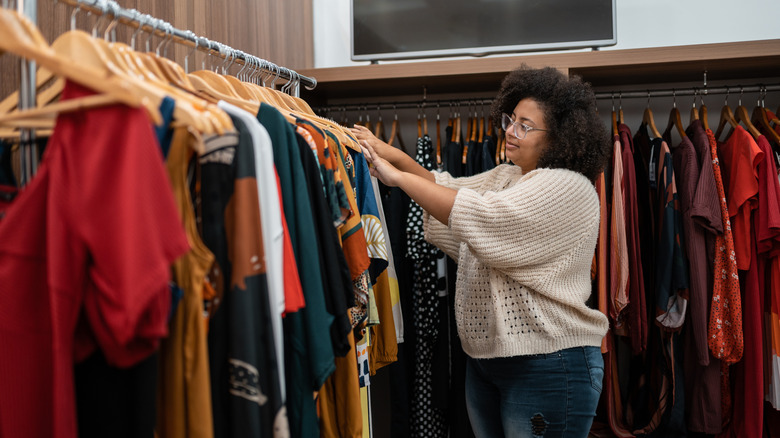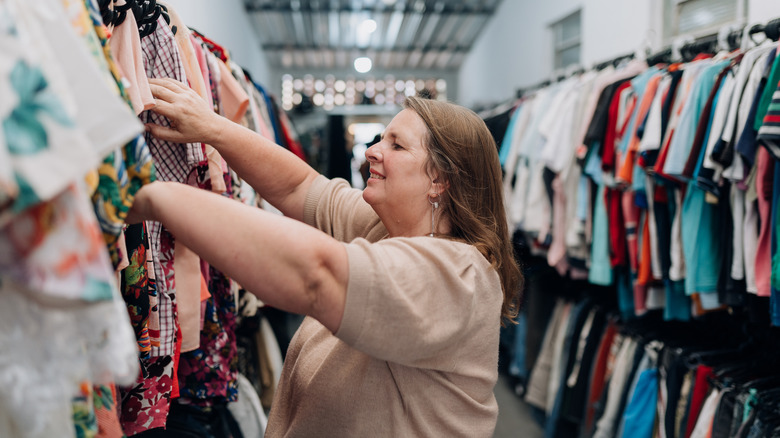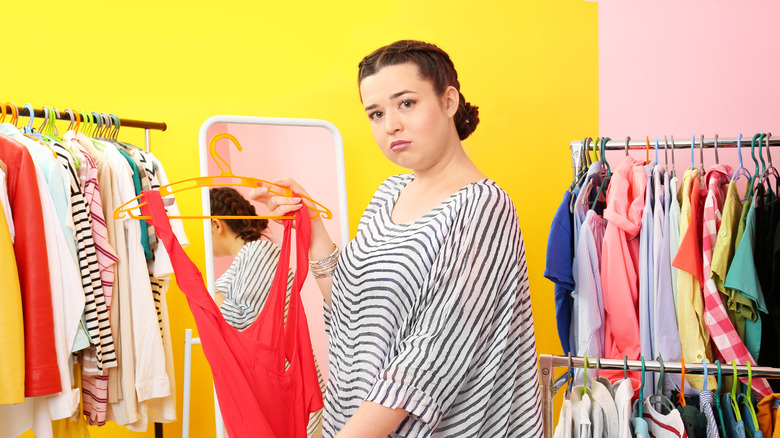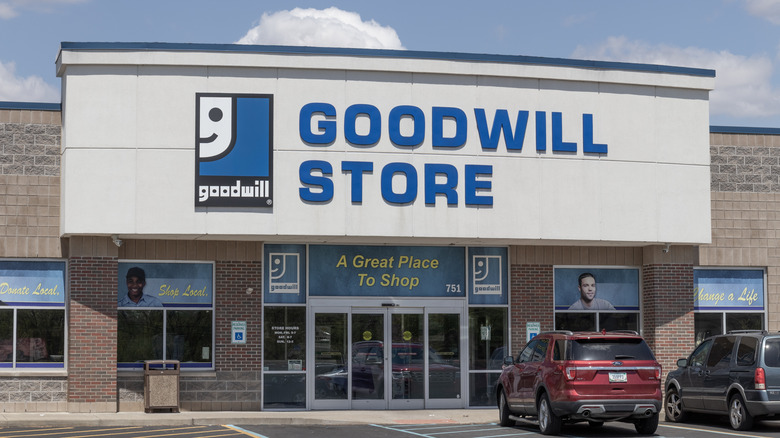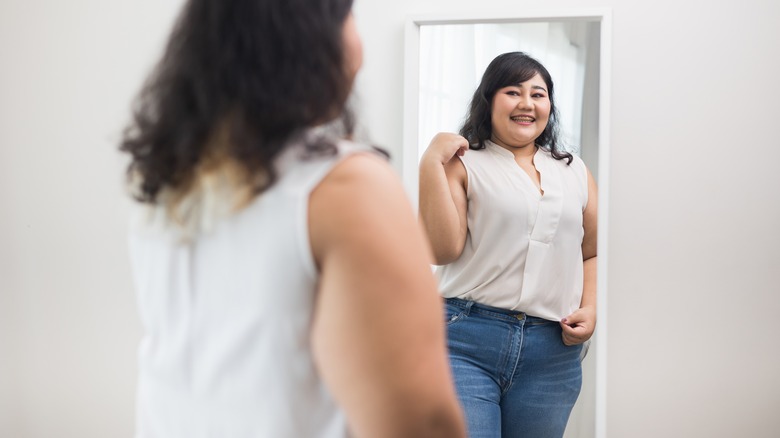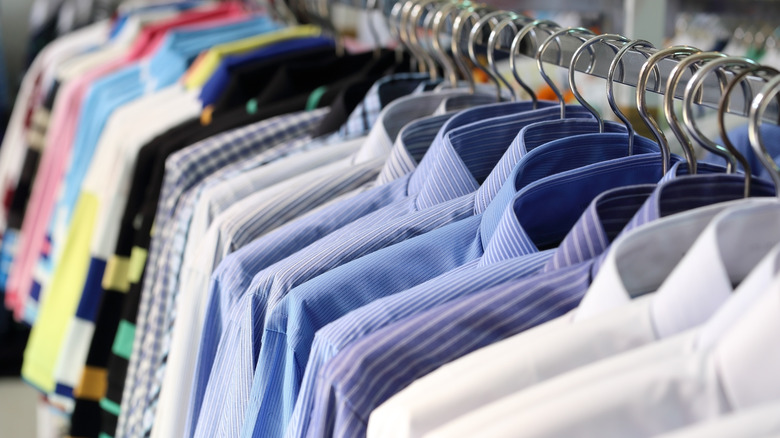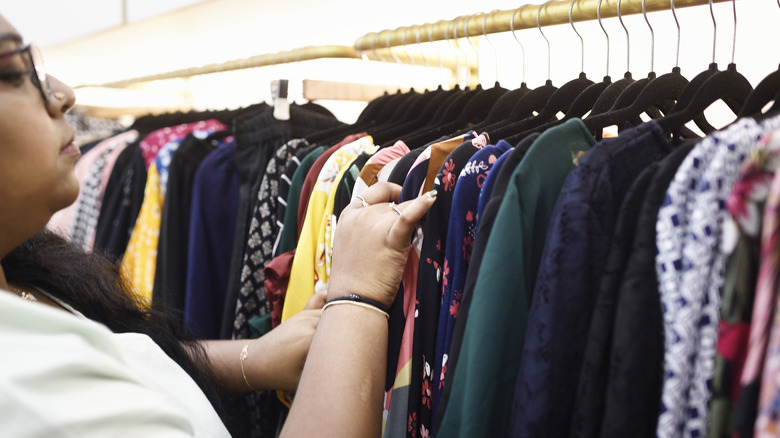Breaking Down The Barriers Between Plus-Sized Bodies And Thrifting Culture
Thrifting is an awesome way to expand your wardrobe and contribute to making the fashion industry more sustainable. But if you're over a size 20, then you know all about how hard it is to find any clothes at thrift stores, let alone fashionable clothes.
The thrifting blog Dina's Days explains that the biggest reason thrift stores have such a small plus-size selection is that the vast majority of clothing brands don't produce clothes over a size 20 or XL. So the supply issue is a top-down problem. Only a fraction of those limited options ends up in thrift stores. Thrift stores that buy their stock often won't buy plus-size clothing, and the thrift stores that exclusively take donations don't get a lot of plus-size clothes because when plus-size folks find something they like, due to scarcity, they usually wear it until it falls apart. Often, the only clothes that do make it to the donation bin are clothes so out of style our grandmas wouldn't wear them.
Adding to the problem is the "fashion flipping" trend — when thin folks buy plus-size clothing and alter them to fit their thin bodies. Ragen Chastain, a fat influencer, explains that this trend is rooted in the perception that no one wants the clothes anyway. But some plus-size person really does need those clothes, and "fashion flippers" are taking those clothes from them. Though there are significant barriers to thrifting as a plus-size person, there are ways to make thrifting work for you.
Be prepared to put in the time
Plus-size thrifters can't just walk into any thrift store, browse the racks for 20 or 30 minutes, and walk out with a haul. Simply Sonja, a plus-size fashion vlogger, said in her thrifting videos that she plans to hit three to five stores when she goes thrifting. Even then, she said, there are times when she only finds a few pieces that work in her wardrobe.
So before you start, it's important to understand that thrifting as a plus-size person takes serious time and commitment. Instead of just hopping in the car for a quick trip, you'll need to carve out a good chunk of time, maybe two to three hours, and you'll want to plan which stores you're going to check out. You might even want to bring some purse snacks and a water bottle to make sure you're properly hydrated and fueled. I know — this sounds like a bit much, but trust us, thrifting for clothes above an XL is a marathon.
You'll also need to budget time for finding the plus-size section — which is sometimes tucked away in a corner that might as well be Narnia — and sifting through everything available to find a diamond in the rough. And don't forget time for trying on anything you do manage to find because, as we'll cover in a bit, you absolutely cannot skip the dressing room when thrifting.
Manage your expectations
Before you head out, it's also important to take some time to set your expectations. The limited amount of plus-size inventory that thrift stores do carry tends to sell out fast because it's in such high demand. It's entirely possible that you won't find anything that fits you or that you'd like to wear in public. You have to be prepared for the possibility that you'll invest a bunch of time and energy into thrifting without taking home a single piece of clothing.
It's also important to understand that you might not have that magical moment thinner thrifters have when they find the perfect vintage jacket or little black dress. The plus-size sections of most thrift stores are usually full of generic basics like tees, tanks, and pants, some of which are great finds! But they're not the hidden gems that thinner thrifters tend to find lurking in the racks.
Misty Fritz gives a concrete and fairly typical idea of what a thrifting trip for plus-size clothes might look like in an article for the online zine emFatic. In one trip, she said, she visited three thrift shops, tried on more than 20 pieces of clothing, and went home with just two. So be prepared for frustration and disappointment, and maybe decide ahead of time that finding even one thing you like is a success.
Try the big-name places first
Pretty much every city has a boutique thrift store that everyone loves. Unfortunately, these are typically not the places to find plus-size clothes, says Hannah Rupp, the fashion blogger known as The Outfit Repeater. Every once in a while you'll find something great at one of these boutiques, but usually, if they have any plus-size clothes at all, they're not exactly the most fashionable.
For the most part, big-name thrift stores like Goodwill and the Salvation Army will have a bigger selection than smaller stores. The boutique shops typically buy their clothes or are very discriminating about what they take. Unfortunately, that often means that they reject plus-size clothing. Goodwill and Salvation Army will take literally anything, so they're more likely to end up with some plus-size clothing.
Some Goodwill locations also have partnerships with big-name department stores like Target and will get their unsold merchandise. So you might actually be able to find some trendy, name-brand stuff. Maybe. Remember to keep your expectations low so you're delighted if you do find something amazing. Goodwill and Salvation Army are often organized more like department stores, too, which can make it easier to browse. Bigger locations are typically organized by type of clothing, then size, then color. They're definitely the best choices if you're short on time.
Browse and try on a wide variety of sizes
Any femme person who's ever tried on clothes knows how wild sizes are. There's zero standardization, which means it's nearly impossible to know exactly what size you are. In fact, My Green Closet polled 1,000 people about their clothing sizes and found that 77% of people wear clothes in more than one size.
So if you don't see anything on the rack in the size you normally wear when you're thrifting, don't despair! First, make sure to do a thorough search of the racks. Experts told NPR that plus-sized clothing is often sorted wrong in thrift stores, so there may be items hidden in other sections. Then, grab clothes you like that are a size or two smaller and larger than you normally wear and head to the dressing room.
Even if you loathe dressing rooms, you have to try on everything when you're thrifting because fit matters way more than what it says on the tag. Since the clothes are secondhand, they're probably a bit stretched out, which can work in your favor. Or the fabric might be stretchy enough on its own that a smaller size looks great on you. Bigger sizes may fall in just the right way and give you some extra room to move. And even clothes in your usual size may look different on your body than you'd expect. So treat sizes as a guideline, and be prepared to spend a lot of time in the dressing room.
Don't be afraid to try the men's section
Many femme folks don't venture into the menswear section to shop for themselves. Maybe because they think they won't find anything that fits their style or fits them well. But the men's section of thrift stores — and really any department store, to be honest — can be a treasure trove for any femme person looking to expand their wardrobe.
As LaToya Wright of The Fat Girl of Fashion points out, plus-size people assigned female at birth (AFAB) tend to have broader shoulders, rounder waists, and longer limbs than thinner AFAB folks, and menswear is cut to accommodate all of these traits. Menswear tends to be more size-inclusive as well (thanks, patriarchy!) because most brands have a "Big and Tall" line. So the plus-size menswear section of your local thrift shops is probably much better-stocked than the women's plus-size section.
Obviously, you won't find the perfect blouse or skirt in the menswear section, but you can find some great T-shirts, jeans, slacks, sweatshirts, and button-ups, which you can wear unbuttoned over a tee or tank. Since men's clothing is sized differently than women's, be sure to look up size conversions for pants and button-ups, and grab multiple sizes to try on. A large men's shirt may fit you just fine, even if you normally wear a 2X in women's tops.
Don't immediately reject something if the fit isn't quite right
When thrifting, you're probably going to find some pieces you love that don't fit exactly the way you want them to, and as a plus-sized person, you're probably used to settling for clothes that don't quite fit right. But that doesn't have to be your fate forever.
Many plus-size fashionistas, especially those who thrift, swear that altering clothes is a must and do their own simple alterations. This skill opens an entirely new world of fashion because if something is almost perfect but just a little tight or baggy in the wrong places, knowing how to tailor the garment for your body means you never have to leave something you love on the rack. Since the plus-size sections of thrift shops are often understocked, being able to alter your own clothing means you can make the best out of the limited selection.
If learning to sew sounds awful or too time-consuming, you can try to find a plus size-friendly tailor in your area. Be warned, not all tailors will be size-inclusive. Before you try a tailor for yourself, try to get recommendations from other plus-size folks in your area. And yes, a tailor can be expensive. We get that this option isn't accessible to everyone, and it sucks that plus-size folks can't simply rely on always finding clothes that fit. But if you can afford a tailor, it's usually worth it.
Enlist some professional help
Sifting through racks at your local thrift stores is time-consuming, and it can be disappointing as heck. If you don't have the time or the emotional fortitude for that journey, it's absolutely okay! It doesn't mean that thrifting isn't for you. It just means that you'll need to thrift a little differently and get some help from the professionals.
A few thrifting enthusiasts have made a career out of thrifting by offering their services to people all over the country and world. These thrifting pros will literally hunt down exactly what you're looking for by browsing their local shops, connecting with thrift shop owners from all over, and connecting with other thrifting professionals.
Two of these pro thrifters specialize in finding plus-size clothing: Emma at Berriez and Lisa at Two Big Blondes. Both of their websites have a contact form you can fill out with all the details about what you're looking for, and they'll contact you ASAP to arrange your clothing hunt. Of course, their services don't come cheap. They're literally doing all the work of thrifting for you. So this option isn't for everyone, and it's not the best way to stock your entire closet. But it is totally worth it if you're looking for your dream vintage skirt or a dreamy dress for your next big event or jeans that you'll wear almost every day until they literally fall apart. Plus, you'll be supporting professional plus-size fashionistas.
Thrift online
The internet has given us a completely different way to thrift. Instead of spending hours driving to stores and scouring racks, you can search online thrift stores. Some of these stores are stocked with items curated by the shop owner, while others are basically online resale shops where anyone can sell their old clothing. Stella Hertantyo over at Conscious Fashion Collective put together an awesome list of online thrift stores that specialize in plus-sized clothing.
Online thrifting has its downsides, though. Obviously, you can look at, touch, or try on any of the clothes before you buy them. So you might end up with something that doesn't fit the way you want it to or at all. You also can't examine the clothing for wear and tear. While this isn't really an issue with the online thrift stores where the collections are curated, it's definitely a concern with the resale shops where people are selling their own clothes. While thrifting online definitely saves you time and emotional energy, you may still not end up with clothes you like.
To get the best results, look for online thrift shops that post sizing measurements on each item and lots of pictures. That way, you can take your own measurements to determine whether the garment is likely to fit and examine the quality as thoroughly as pictures allow. Even will the downsides, thrifting online can be a great way to access more options and find what you're looking for.
